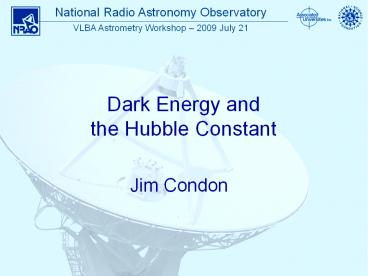Dark Energy and the Hubble Constant - PowerPoint PPT Presentation
Title:
Dark Energy and the Hubble Constant
Description:
What is dark energy (DE)? How does an accurate ( 3%) local measurement of the Hubble constant H0 plus ... Is DE a variable 'quintessence' ... – PowerPoint PPT presentation
Number of Views:77
Avg rating:3.0/5.0
Title: Dark Energy and the Hubble Constant
1
Dark Energy and the Hubble Constant
- Jim Condon
2
- What is dark energy (DE)?
- How does an accurate (? lt 3) local measurement
of the Hubble constant H0 plus CMB data
constrain DE? - How can astrometry determine H0?
- Bonus accurate SMBH masses
- The Megamaser Cosmology Project
- http//wiki.gb.nrao.edu/bin/view/Main/MegamaserCos
mologyProject - Jim Braatz, Jim Condon, Fred Lo (NRAO)
- Mark Reid (CfA)Christian Henkel (MPIfR), Ingyin
Zaw (NYU),...
3
How can the universe accelerate?
Only energy density ? and pressure p are
relevant. For each constituent of the Universe,
define w ? p / ?. For nonrelativistic matter, w
0 for radiation, w 1/3. Acceleration
requires a sufficiently negative pressure w lt
-1/3 e.g., the quantum vacuum has constant w
-1 (but wildly wrong energy density). Is DE a
variable quintessence? H0 plus CMB data
constrain w via the expansion history of the
universe.
4
WMAP 5-year TT power spectrum
- Absolute angular-size distance to z 1089
- linear size (theory) / angular size (observed)
5
The CMB and H0
While models with ?DE0 are not disfavored by
the WMAP data only, the combination of WMAP data
plus measurements of the Hubble constant strongly
constrain the geometry and composition of the
universe Spergel et al. 2006 The single most
important complement to the CMB for measuring the
DE equation of state at z 0.5 is a
determination of the local Hubble constant to
better than a few percent.---Hu, W. 2005, Dark
Energy Probes in Light of the CMB, ASPC 339, 215
Spergel et al., 2006
6
The Impact of an H0 Prior
HST Key Project H0 72 (Freedman
et al. 2001) Sandage et al. (2006) H0 62
7
Geometric Distances to H2O Megamasers
NGC 4258
D r/?? a Vr2/r D Vr2/(a ??)
NGC 4258
r
rotation-line slope of systemic masers
2Vr
satellite-line rotation curve
2??
?
?
8
Two methods to calculate the distance D
- Rotation curve of satellite-line masers
- vsat2 ? M/(D?sat) ? M/D
- Rotation-line slope of systemic masers
- dvsys / d? ? M/(D?r3)1/2 ? ?r
- Acceleration of systemic masers
- (1) ar ? vsys2/(D?r) ? D ? M
- Proper motion of systemic masers
- (2) d?/dt vt/D ? (M/D3)1/2 ?r1/2 ? M ? D
?sat
?r
9
Megamaser Cosmology Project goals
- Detect N gt 10 suitable H2O megamasers
(strong enough for VLBAGBT, in edge-on disks)
at distances D 100 Mpc (in Hubble flow) around
the sky and measure their recession speeds - Measure their geometric distances to 10 each
via acceleration, mapping, and proper motion.
Correct for known velocity fields to determine
the average H0 within 3, assuming random errors.
10
Step 1 Detections and velocities
11
(No Transcript)
12
GBT Spectra of Some Maser Disks
13
Step 2 Measure Accelerations
.
14
Step 3 Imaging GBT VLBA
- The GBT lets us
- Image fainter (more distant) H2O masers
- Use fainter (closer on the sky) continuum
phase calibrators or even line self-calibration
(NGC 1194 S gt 500 mJy during flares)
15
UGC 3789 Results
R 0.09 - 0.20 pc (0.40 -
0.87 mas) V 750 - 450 km/s Mbh 1.2 x 107
Msun a 3.6 km s-1 yr-1 (mean value) D
50 Mpc 13 H0 71 10 km s-1 Mpc-1
16
Direct measurements of SMBH masses
Galaxy Radius (pc) Mbh (Msun) Mrk 1419 0.05
0.30 7.5 106 NGC 1194 0.58 1.41 6.6 107 NGC
2273 0.03 0.08 7.6 106 NGC 6264 0.23
0.78 2.5 107 NGC 6323 0.11 0.29 1.0 107 UGC
3789 0.08 0.30 1.1 107
17
Summary
- An accurate ( lt 3) measurement of H0 independent
of the CMB and other techniques (e.g. distance
ladder) is critical for characterizing dark
energy, testing the flat ?CDM model, and fixing
fundamental cosmological parameters (e.g.
deriving ?m from the CMB observed ?mh2). - Recent observations of megamaser disks support
the feasibility of using the GBT and VBLA to
measure H0 directly. - Astrometry yields accurate masses of SMBHs































